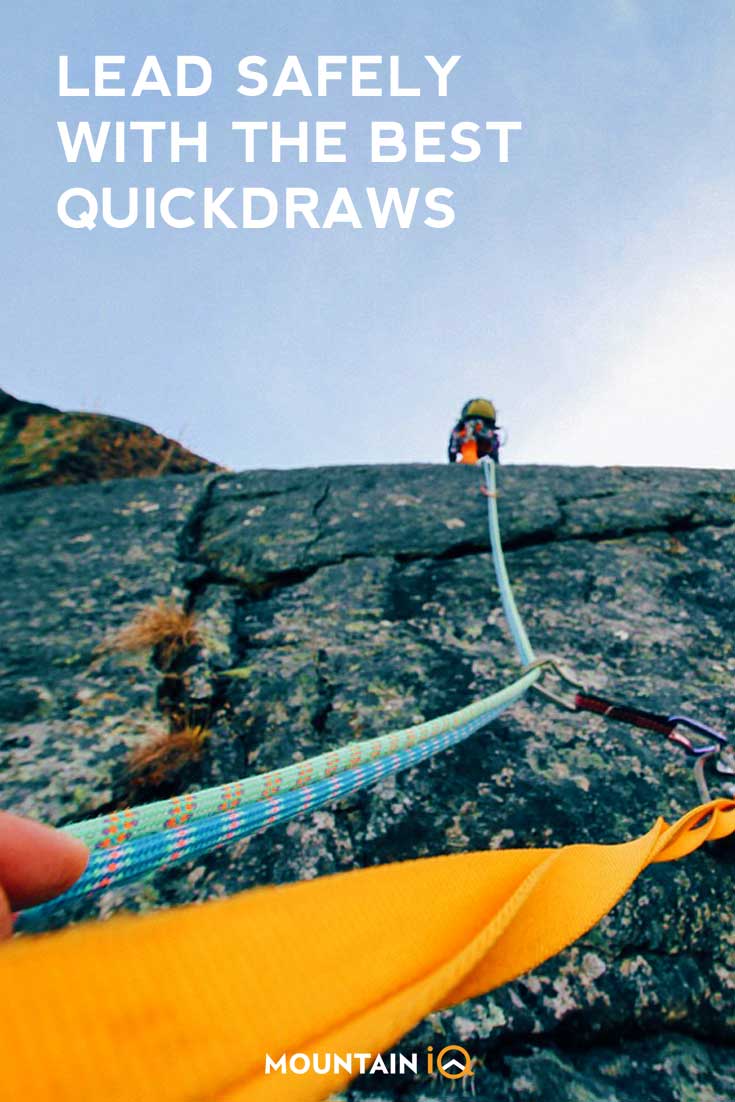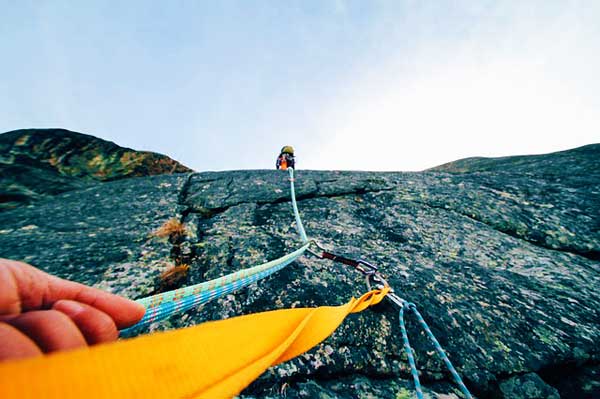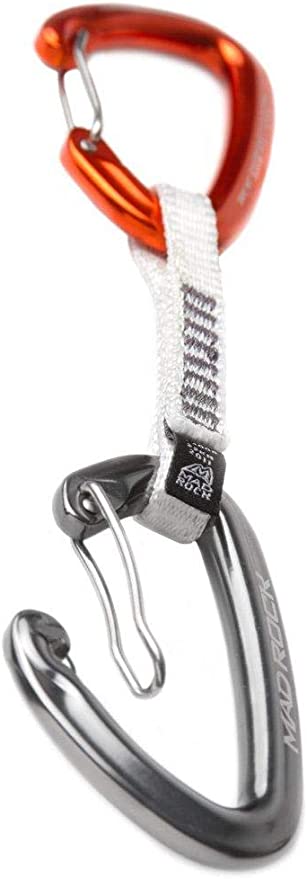When it comes to the best quickdraws for climbing, you can't go wrong with the Petzl Spirit Express. I've used it on numerous terrains, and it performs excellently every time! It's extremely versatile and I felt really secure using its unique keylock system which stops the carabiner from snagging when clipping and unclipping myself during climbs.
I also really enjoyed using the Black Diamond LiteWire. It's very lightweight (as the name suggests) and handles multi-pitch missions with tremendous ease. It gives you great stability with its straitjacket insert which keeps the bottom biner in the optimal clipping position.
Best Quickdraws (Top Picks)
Check Latest Prices
Best Value
Best Beginner
This article contains affiliate links. If you buy something through the links on this page we might get a small commission. It will not affect your price, but helps keep our site alive!
Top Quickdraws For Climbing
We reviewed over 16 quickdraws for this article. Below are the best quickdraws that made our short list.
- Petzl Spirit Express - Best Overall
- Black Diamond LiteWire - Best Lightweight
- Mad Rock Concorde
- Petzl Djinn Axess - Best Beginner
- Black Diamond HotWire - Best Value
Read our complete buyers guide for quickdraws.
Best Overall Climbing Quickdraws
1. Petzl Spirit Express
The Petzl Spirit Express is a well-known and well-loved quickdraw amongst climbers, and experienced readers wouldn’t be surprised to see it at the top of our list.
The Spirit Express is one of Petzl’s strongest quickdraws. The keylock carabiners on this quickdraw are super smooth and makes clipping fast and sturdy, with keylock noses so that the rope never snags on the keylock gate.
The dogbone is stable-feeling – staying rigid when you clip overhands - while its width makes it easy to grab.
All the materials used to make the high-quality Spirit Express are incredibly strong and durable, following the spirit of a climber.
Even the rubber grommet keeping the rope-side of the carabiner from flipping over is rigid.
As light and strong as this quickdraw is, however, we advise not to purchase it for long or alpine climbs.
Check Latest Prices
Main Features
What we like
What we dislike
Key Takeway
Petzl’s tried-and-true Spirit Express is a favourite amongst climbers, with its smooth and snappy clipping action and its strong and durable design. For a sport climbing quickdraw, this is the best model you can buy.
2. Black Diamond LiteWire Quickpack of 6
At only 63 grams, this quickdraw is Black Diamond’s lightest quickdraw as well as over 20 grams lighter than any other quickdraw on our list!
LiteWire (as in “ounce” due to their 1-ounce carabiners) has a unique design – instead of a rigid dogbone, it has a thin, flexible sling.
This - alongside its light, hot-forged carabiners - are what shaves off those extra grams while staying $4 cheaper than its nearest competition (the Petzl Ange Finesse).
The Oz also features the snag-free HoodWire Technology. This uses a patent-pending, stainless-steel wire hood that brings keylock functionality to carabiners so that they won’t snag on slings or bolt hangers.
Check Latest Prices
Main Features
What we like
What we dislike
3. Mad Rock Concorde
Smaller carabiners are great for sports climbing, and with the lightweight of the Concorde this quickdraw also works wonders for trad. Mad Rock is known for offering high-quality and high-performance gear, and the Concorde quickdraws hold true to this tradition.
The Dyneema material used to make the fabric dogbone is sleek and light without compromising strength. The warm-forged aluminium wiregate carabiners are stronger than most, with a higher KN rating (strength measurement) than a lot of larger, heavier ones.
They are also extremely easy and smooth to clip, with a rubber liner on one end of the dog bone that helps maintain proper orientation of the carabiner when clipping.
Their all-round size, weight and price make it easier to purchase and you can carry a lot more Concorde Quickdraws than you could with many other quickdraw models. A lot of users claim that they are as strong and as reliable as anything you’d pay double for.
Check Latest Prices
Main Features
What we like
What we dislike
Key Takeaway
Overall, the Mad Rock Concorde's portability and lightweight alongside its strength make it perfect for any lead or sport climber.
4. Petzl Djinn Axess
The Petzl Djinn Axess Quickdraw is easy to use and durable enough to allow a clean initiation into outdoor climbing, making it the best quickdraw for climbing newbies.
The Djinn carabiners are larger than average, making them easier to handle and they work well with gloves. Their H-shaped profiles offer fantastic strength while remaining light.
The lower carabiner has a slight curve in the spine that sits nicely in the your hand, as well as a wide rope-bearing surface that is designed to promote rope glide while reducing wear.
The dogbone is thick enough to grab with comfort, and a rubber wedding protector at the bottom of the sling reduces abrasion and keeps the lower carabiner properly positioned.
The weight of the Djinn is a downfall, but for new sport climbers this isn’t a massive concern - its ease of use makes it easy to forgive.
Check Latest Prices
Main Features
What we like
What we dislike
Key Takeaway
The Petzl Djinn Axess’s large carabiners are easy to use and very forgiving while the overall quickdraw construction is reliable and strong – making it perfect as a first quickdraw purchase.
5. Black Diamond HotWire
A quickdraw for under $20? It’s hard to believe, but Black Diamond made it possible. What’s more, you can find the HotWire for even cheaper in their set packs of 6. The cheap price makes it easy to doubt the HotWire at first, but the 24Kn carabiners used will change that quickly.
They offer full wire gate performance with a no-frills construction, and combined with a polyester dog bone, this quickdraw will catch your fall similar to any of the other models mentioned on this list. The rubber Straitjacket insert in the dog bone also keeps the bottom carabiner in its proper position for easy clipping.
Ultimately, this quickdraw is strong and durable enough to do what it needs to do - no less and no more. Due to their price, you can buy a good amount without breaking the bank to place them tactically for emergencies.
Check Latest Prices
Main Features
What we like
What we dislike
Key Takeaway
The Black Diamond HotWire Quickdraw is not the lightest, cleanest, fanciest quickdraw out there, but it costs half the price and gets the job done well.
Belay Device - Buyer's Guide (Key Features)
Carabiner Gates
You get three types of carabiner gates on your quickdraw: straight, bent and wire. Because a quickdraw consists of 2 carabiners, you may also get a combination.
The most common type is the straight-gate carabiner. These, as the name suggests, are perfectly straight from the pivot point to the end. They are easy to use.
Bent-gate carabiners have a concave gate. They are reserved for the rope-end of quickdraws because their shape makes clipping a rope quick and easy.
A carabiner with a straight or bent-gate may be a keylock carabiner, which has a smooth notch where the nose of the carabiner and the gate interact. This prevents the carabiner from hooking and catching onto things, making clipping and unclipping much easier.
If a loop of stainless-steel wire acts as a gate, it is a wiregate carabiner. Wiregates are lighter and also less likely to vibrate open during a fall compared to solid gates. They cannot have the keylock feature that some straight or bent gear carabiners have, but they sometimes have hooded noses that can prevent snagging, similar to a keylock nose.
Sling Length
Short-length slings (a.k.a dogbones) range between 10cm and 12cm. They work in most situations when the route is straight.
Medium-length slings are 17-18cm and great for reducing rope drag. They are ideal for routes that require more than 12 quickdraws, or for routes that aren’t straight. Longer slings tend to be heavier and bulkier.
For sport climbing, it is advised to have a selection of both lengths so that you may be ready for whatever the route has in store. Trad climbers use alpine or extendable quickdraws (the latter refers to a technique in racking the quickdraw so that the sling can be shortened and then extended as needed).
Carabiner Size and Shape
Alongside the gate type, you should consider the carabiner size and shape.
Firstly, note that the smaller a carabiner is the lighter it is, but it is also more difficult to manipulate. If you’re introducing yourself to quickdraws, opt for larger ones to begin with as they are easy to use and more forgiving.
The shape can also affect the carabiners ease of use, especially for large hands. The best way to know if a carabiner will work with your hand size or not is to go into a local shape and get a feel for them manually. You want to be able to unclip and clip your carabiner with a stealthy, light grip, and this requires a nimble fit in your hands.
Quantity
It’s all good to invest in quality over quantity. But if you’re planning on tackling a long route that requires 24 quickdraws, blowing your whole budget on a handful of carabiners won’t get you there.
Evaluate what routes you’re going to undertake. Most sport routes require 12 quickdraws, making them a good start. Longer routes (30m+) need 16-18 quickdraws. Longer routes will use 24 or more quickdraws. Guidebooks list the number bolts on a route, which will be your quickdraw total.
Consider what you’re getting for your money. Hot-forged carabiners ten to cost more than cold-forged, yet it has been said that cold-forging produces a better product. And although stainless-steel is stronger, aluminium does a great job and is cheaper. Check reviews to see how users have found the products.
More Features to Consider
Other things to take note of before purchase:
- Carabiner Strength: Product pages should show their kn rating.
- Carabiner Gate Open Clearance: This refers to the width that a gate can open. Usually the smaller the carabiner, the less clearance it has. The bigger the clearance, the easier it will be to handle.
- Sling Material: UHMW polyethylene is stronger and lighter than nylon or polyester but it will cost more.
- Sling Width: Thinner slings are lighter, while wider ones are easier to handle.
Continue browsing
See more outdoor equipment reviews and our detailed climbing gear guide. Or check out these reviews:







